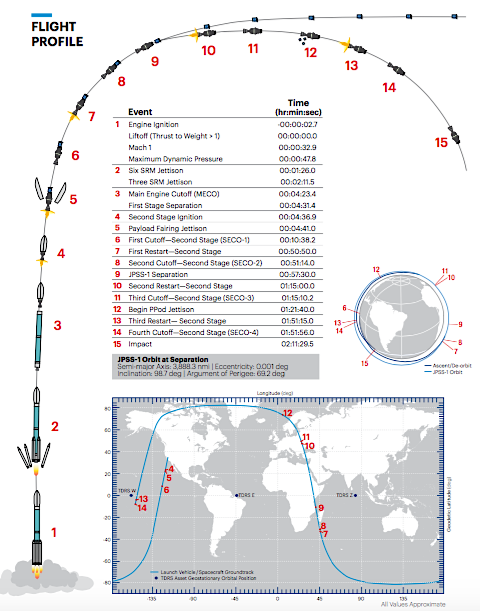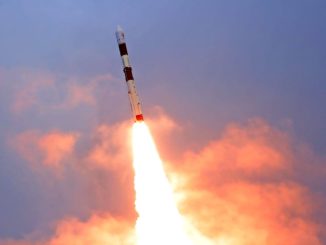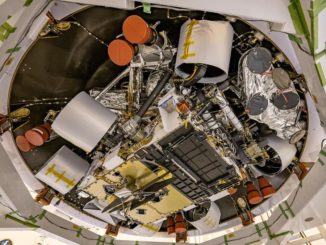EDITOR’S NOTE: Updated at 9 a.m. EST (1400 GMT) on Nov. 14 after launch scrub and on Nov. 17 in advance of third launch attempt.
A Delta 2 rocket boosted by nine strap-on motors and two liquid-fueled stages will launch NOAA’s JPSS 1 weather satellite into a 511-mile-high (822-kilometer) orbit following liftoff from Vandenberg Air Force Base, California.
It will take 57-and-a-half minutes to deliver the JPSS 1 satellite to orbit from liftoff until spacecraft separation.
Launch is set for a 66-second window opening at 1:47:03 a.m. PST (4:47:03 a.m. EST; 0947:03 GMT) Saturday from Space Launch Complex 2-West at Vandenberg after two scrubbed countdowns earlier in the week.
The command to start the Delta 2’s first stage RS-27A main engine is set for T-minus 2.7 seconds. After passing a computer health check, six of the Delta 2’s nine strap-on solid rocket boosters will ignite to send the launcher south from Vandenberg, following an arcing trajectory over the Pacific Ocean bound for polar orbit.
The RS-27A engine, manufactured by Aerojet Rocketdyne, will generate around 200,000 pounds of thrust at liftoff, consuming a mix of RP-1 kerosene and liquid oxygen. Each 40-inch-diameter (1-meter) booster ramps up to 145,000 pounds of thrust in vacuum.
The Delta 2 will surpass the speed of sound in 32 seconds and reach the phase of flight with maximum aerodynamic pressure at approximately T+plus 48 seconds. The six ground-lit boosters will burn for about 63 seconds, and three air-lit boosters will ignite around two seconds later to continue the climb into space.
The six burned-out motors will release in sets of three from the Delta 2 at about T+plus 1 minute, 26 seconds, jettisoning once the launcher is clear of offshore oil rigs. The other three boosters will consume their pre-packed solid propellants before separating to fall into the Pacific Ocean at T+plus 2 minutes, 12 seconds.
The Delta 2’s main engine will continue firing until T+plus 4 minutes, 23 seconds. Seven seconds later, the rocket’s first stage will detach, giving way to the upper stage’s AJ10-118K engine to ignite at T+plus 4 minutes, 37 seconds.
Separation of the launcher’s composite nose fairing is scheduled for T+plus 4 minutes, 41 seconds, once the Delta 2 is out of the lower atmosphere, exposing the JPSS 1 satellite to space for the first time.

Burning a blend of Aerozine 50 and nitrogen tetroxide storable liquid propellants, the second stage engine will fire until T+plus 10 minutes, 38 seconds, to place the JPSS 1 spacecraft in a preliminary egg-shaped elliptical orbit.
After coasting over Antarctica, the AJ10-118K engine will reignite at T+plus 50 minutes, 50 seconds. The 24-second burn will circularize the upper stage’s orbit at an altitude of approximately 511 miles (822 kilometers) and an inclination of 98.7 degrees for deployment of the JPSS 1 weather satellite at T+plus 57 minutes, 30 seconds.
A third upper stage maneuver at T+plus 1 hour, 15 minutes, will last for 10 seconds to fine-tune the orbit for release of five CubeSat secondary payloads sponsored by NASA and developed by universities and institutions in Arizona, Idaho, Massachusetts, Tennessee and Australia.
The CubeSats will pop out of their launch containers beginning at T+plus 1 hour, 21 minutes, 40 seconds.
One more second stage firing will de-orbit the rocket to burn up in Earth’s atmosphere.
Email the author.
Follow Stephen Clark on Twitter: @StephenClark1.



